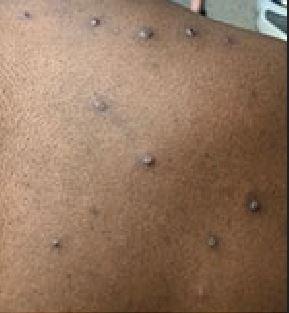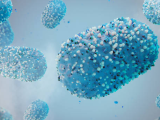A study of almost 400 samples taken from men with monkeypox reveals a high prevalence of the virus on skin, throat, and anus swabs compared to in blood or urine—with detections in semen in the midrange—and high viral loads in skin and anal swabs.
Two other new studies detail transmission risk in a tattoo parlor and in healthcare settings, and in US news, officials report a monkeypox-related death in Ohio.
Viral DNA found on skin swabs of 88% of men
The new analysis of 356 samples from 50 men in France infected with monkeypox shows that viral DNA detection via polymerase chain reaction (PCR) was more frequent from skin (88% of men), throat (77%), and anus (71%) swabs, than from semen (54%), blood (29%), or urine (22%).
The highest viral DNA loads were consistently found in skin and anus swabs, and lesions were common on the anus and genitals, which continues to suggest sexual contact as the main route of transmission. The study, published in The Lancet Infectious Diseases is one of several new studies that aim to describe real-world transmission risks of the poxvirus.
The researchers assessed viral load using cycle threshold (Ct) values, which are lower when viral loads are high. Viral loads were significantly higher from skin lesions (Ct, 19.8) and anal samples (Ct, 20.9) than from throat (27.2), semen (27.8), urine (31.1), or blood (32.8) samples.
The median age in the study was 34, with 44% of the men HIV-positive. By day 14 of swabbing, the proportion of positive samples dramatically decreased on the skin, and in anus, throat, blood, urine, and semen samples.
"High MPXV viral loads from skin and mucosa, including genital and anal sites, suggest that transmission most likely occurs through direct body contact rather than through the respiratory route or contact with body fluids, which should help to refine the prevention messages delivered to individuals most exposed to the virus," the authors wrote.
They added, "The detection of MPXV at high concentrations in the anal region, in the mouth, and in semen is consistent with the sexual practices potentially involved in the spread of the virus among men who have sex with men, in addition to skin contact related to sexual or non-sexual proximity."
In a commentary on the study, Italian researchers said the findings add to a growing body of literature on monkeypox transmission, which is urgently needed as the world has seen more than 50,000 cases in the past 4 months, with 95% in men who have sex with men.
"More extensive investigations are needed to obtain a coherent understanding of transmission factors that have permitted the extraordinary penetration of active MPXV infection into human communities worldwide," the authors said.
High attack rate in tattoo-linked outbreak
Also published in the Lancet Infectious Diseases is a report on several monkeypox cases linked to a piercing and tattoo parlor in Cadiz, Spain. Of 54 exposed clients, 20 (37%) contracted the disease from Jul 19 to Aug 3.
All piercings and tattoos were performed by one female employee who did not have monkeypox, but was in close contact with a possible index case on Jul 6. That person got a piercing while experiencing a rash and generalized skin inflammation.
Among the 20 exposed clients, 8 were under the age of 18 and 13 were female. In 90% of the cases, patients developed a rash at the piercing or tattoo site. Subsequent surface sampling showed extensively contaminated and unhygienic conditions, with detectable monkeypox viral DNA on work tables and chairs, and sharps and other work instruments.
"Together, these findings suggest that monkeypox virus can be transmitted through exposure to contaminated piercing or tattoo material and, potentially through contaminated hands, due to poor aseptic measures and handling of materials," the authors concluded.
Nurses infected after collecting samples
In another study highlighting transmission routes, practitioners writing in Emerging Infectious Diseases describe the infections of two Brazilian nurses 5 days after collecting samples from a monkeypox patient.
The authors say the virus was most likely transmitted via contact with contaminated objects. The nurses visited with the patient in his home and had no skin-to-skin contact with the patient, and they reported no sharps injuries. They wore N95 respirators and gloves, but did not sanitize clipboards and specimen-collection boxes.
"Our report provides evidence supporting the hypothesis that both [healthcare workers] infections observed in this study were transmitted through fomite exposure with surfaces in the patient's home, their own [personal protective equipment], or outer surfaces of the specimen transport box," the authors wrote.
US tracks second monkeypox death
In US developments, Ohio has reported its first monkeypox death, in a man with underlying health conditions. This marks the second confirmed monkeypox death in the United States.
The United States has confirmed 25,613 monkeypox cases. In its third technical report on the outbreak, the US Centers for Disease Control and Prevention said activity seems to have peaked in August. The median age of patients is 34, and there was (as of yesterday) one official death linked to the virus.
US officials have confirmed 29 pediatric cases, according to the report.




















